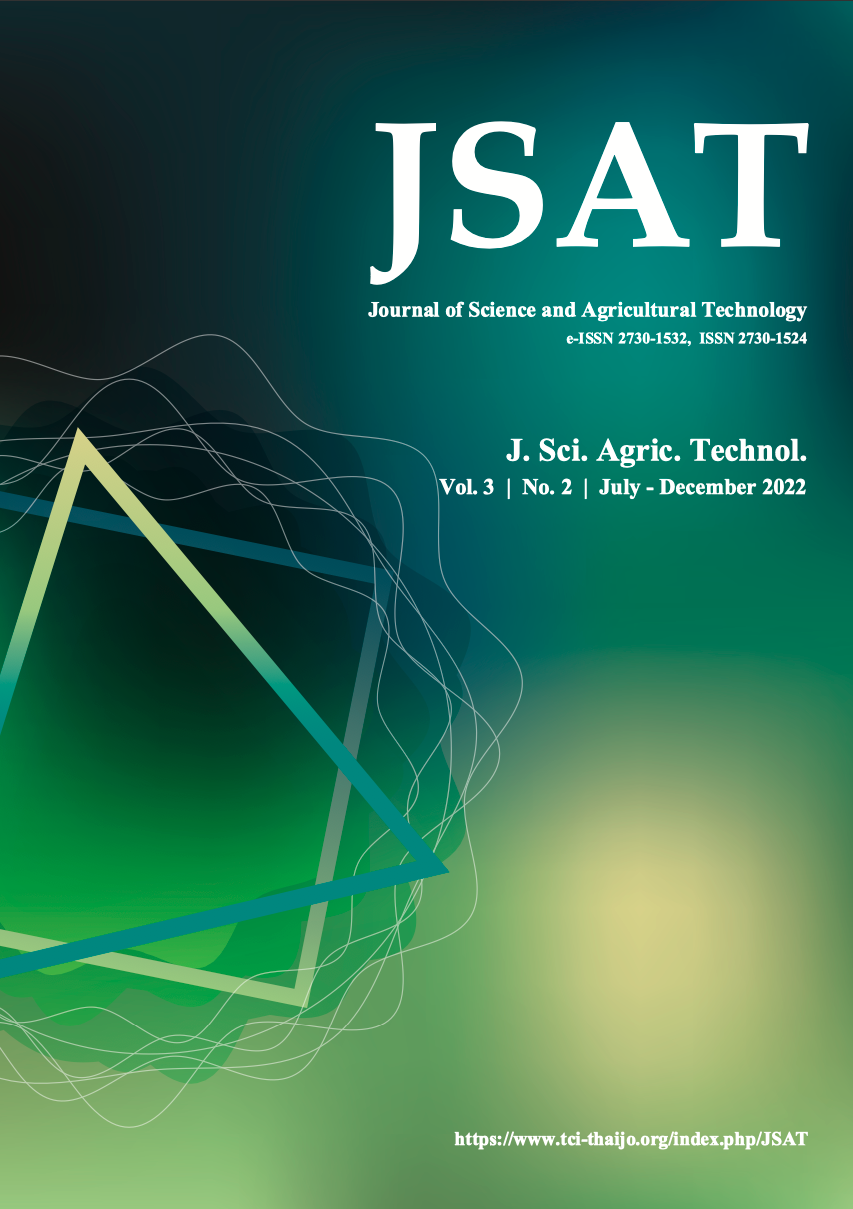Case study: Evaluation of implementations of good dairy farming practice (GDFP) at SRC Animal Health Dairy Farm, Nakhon Ratchasima, Thailand
Main Article Content
Abstract
Article Details

This work is licensed under a Creative Commons Attribution-NonCommercial-NoDerivatives 4.0 International License.
References
Asminaya, N. S., Bani, A., Sandiah, N., Muhsafaat, L., Irawan, F. Y., Indi, A., and Sulfitrana, A. 2020. Earth and environmental science. IOP Conf. Ser. Earth Environ. Sci. 465: 012055.
Atrian, P., and Shahryar, H. A. 2012. Heat stress in dairy cows. Res. Zool. 2: 31-37.
Blokhuis, H.J. 2009. Welfare Quality assessment protocol for cattle. Welfare Quality Consortium. Lelystad, Netherlands.
Burger, M. 2017. Nutritional factors affecting the occurrence of laminitis in dairy cows: a review. Elsenburg Journal. 14 (1): 59-64.
CIWF. 2013. Dairy cow-calf separation and natural weaning. Compassion in World Farming. Online available at: https://www.compassioninfoodbusiness.com/media/5822658/cow-calf-separation-and-natural-weaning.pdf. Accessed on September 30th, 2021.
De Bloom, J., Geurts, S.A., Sonnentag, S., Taris, T., de Weerth, C., and Kompier, M.A. 2011. Health and well being. Psychology & Health. 26: 1606-1622.
Efata, K. B. 2018. Addition of feed with and without pineapple leaves on protein and lactose levels of FH (Frisian Holstein) crossbred dairy cows in Ngancar District, Kabupaten Kediri. Undergraduate Thesis. Wijaya Kusuma University, Surabaya, Indonesia. (in Indonesian).
Ettema, J.F. and Santos, J.E.P. 2004. Impact of age at calving on lactation, reproduction, health, and income in first-parity Holsteins on commercial farms. Journal of dairy science. 87(8): 2730-2742.
FAO and IDF. 2011. Guide to good dairy farming practice: Animal Production and Health Guidelines. No. 8. Food and Agriculture Organization of United Nations and International Dairy Federation, Rome, Italy.
Gabler, M.T., Tozer, P.R., and Heinrichs, A.J. 2000. Development of a cost analysis spreadsheet for calculating the costs to raise a replacement dairy heifer. Journal of Dairy Science. 83(5):1104-1109.
Gaughan, J.B., Davis, M.S. and Mader, T.L. 2004. Wetting and the physiological responses of grain-fed cattle in a heated environment. Australian Journal of Agricultural Research. 55(3): 253-260.
Gleeson, D., Flynn, J. and Brien, B.O. 2018. Effect of pre-milking teat disinfection on new mastitis infection rates of dairy cows. Irish veterinary journal. 71(1):1-8.
Heisey, P. W., and Rubenstein, K.D. 2015. NAE Global Chapter 4. United State Department of Agriculture. 139: 1-29.
Hultgren, J. and Bergsten, C. 2001. Effects of a rubber-slatted flooring system on cleanliness and foot health in tied dairy cows. Preventive veterinary medicine. 52(1):75-89.
Keeling, L., Evans, A., Forkman, B., and Kjaernes, U. 2013. Welfare Quality® principles and criteria. In H. Blokhuis, M. Miele, I. Veissier, & B. Jones (eds.), Improving farm animal welfare: science and society working together: the Welfare Quality approach. Wageningen Academic Publishers, Wageningen. p. 91-114.
Kendall, P. E., Verkerk, G.A., Webster, J.R., and Tucker, C.B. 2007. Sprinklers and shade cool cows and reduce insect-avoidance behavior in pasture-based dairy systems. Journal of Dairy Science. 90(8): 3671-3680.
Krömker, V., and Leimbach, S. 2017. Mastitis treatment-reduction in antibiotic usage in dairy cows. Reproduction in Domestic Animals. 52: 21-29.
LeBlanc, S. J. 2008. Postpartum uterine disease and dairy herd reproductive performance: a review. The Veterinary Journal. 176(1): 102-114.
Legrand, A., Schütz, K. E., and Tucker, C. B. 2011. Using water to cool cattle: Behavioral and physiological changes associated with voluntary use of cow showers. Journal of dairy science. 94(7): 3376-3386.
Makin, M. 2011. Management of dairy farming. 1st ed. Graha IImu Publisher, Yogyakarta. (in Indonesian).
Marshall, E., Aillery, M., Malcolm, S., and Williams, R. 2015. Climate change, water scarcity, and adaption in the U.S. Field Crop Sector. ERR-201. United States Department of Agriculture, Washington DC.
Muktar, Y., Mamo, G., Tesfaye, B., and Belina, D. 2015. A review on major bacterial causes of calf diarrhea and its diagnostic method. Journal of Veterinary Medicine and Animal Health. 7(5): 173-185.
Ponnusamy, K., and Devi, M. K. 2017. Impact of integrated farming system approach on doubling farmers’ income. Agricultural Economics Research Review. 30(conf): 233-240.
Prastowo, S., Nugroho, T., Mahfudhoh, N., Putra, F. Y., Subiakti, Ratriyanto, A., Susilowati, A., Sutarno, Widyas, N. 2019. Milk production of imported Holstein cows over different environment. IOP Conf. Ser. Mater. Sci. Eng. 633: 012021.
Quddus, M. A. 2012. Adoption of dairy farming technologies by small farm holders: practices and constraints. Bangladesh Journal of Animal Science. 41(2): 124-135.
Ribeiro, E.S., Monteiro, A.P.A., Lima, F.S., Ayres, H., Bisinotto, R.S., Favoreto, M., Greco, L.F., Marsola, R.S., Thatcher, W.W., and Santos, J.E.P. 2012. Effects of presynchronization and length of proestrus on fertility of grazing dairy cows subjected to a 5-day timed artificial insemination protocol. Journal of Dairy Science. 95(5): 2513-2522.
Sant’Anna, A. C., and da Costa, M. P. 2011. The relationship between dairy cow hygiene and somatic cell count in milk. Journal of dairy science. 94(8): 3835-3844.
Suherman, D. 2005. Ratio of native grass and concentrate in the ration to the quality of milk production of Holstein cow. Anim. Agric. J. 7: 14-20.
Steel, R.G.D., Torrie, J.H. and Dicky, D.A. 1997. Principles and procedures of statistics, a biometrical approach. 3rd ed., McGraw Hill, Inc. Book Co., New York.
Suriyasathaporn, W., Chupia, V., Sing-Lah, T., Wongsawan, K., Mektrirat, R., and Chaisri, W. 2012. Increases of antibiotic resistance in excessive use of antibiotics in smallholder dairy farms in northern Thailand. Asian-Australasian journal of animal sciences. 25(9): 1322.
Susanti, S., and Marhaeniyanto, E. 2007. Digestibility, nitrogen retention and their relationship to milk production in Friesian Holstein (PFH) cattle fed pollard and rice bran. Jurnal Peternakan. 15: 142-143. (in Indonesian).
Tolosa, T., Verbeke, J., Piepers, S., Supré, K. and De Vliegher, S. 2013. Risk factors associated with subclinical mastitis as detected by California Mastitis Test in smallholder dairy farms in Jimma, Ethiopia using multilevel modelling. Preventive Veterinary Medicine, 112(1-2): 68-75.


